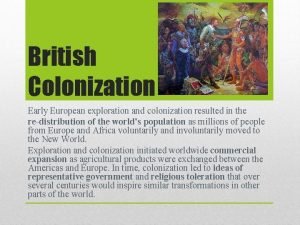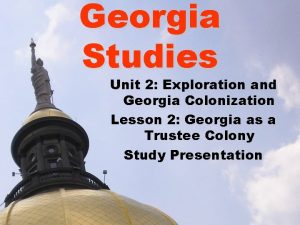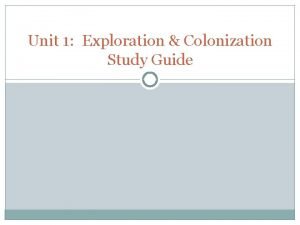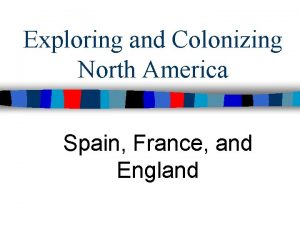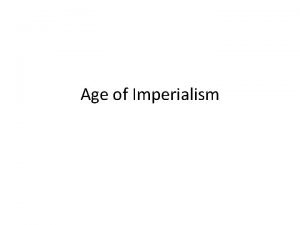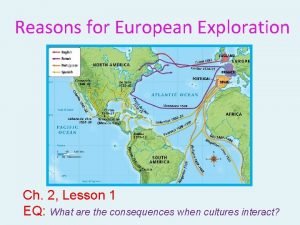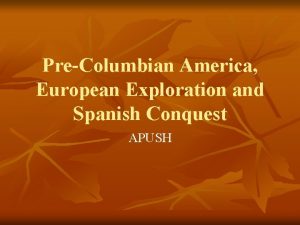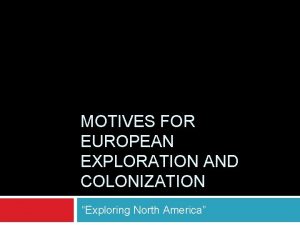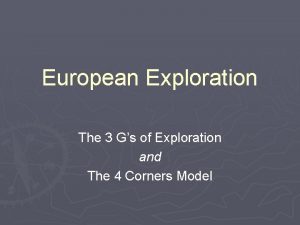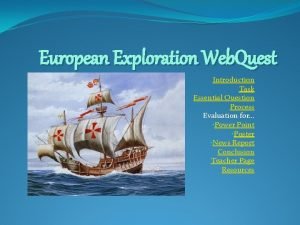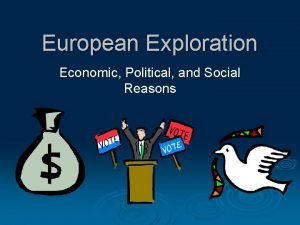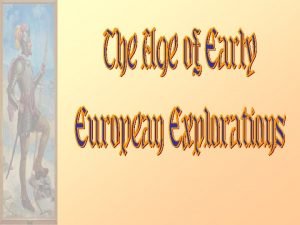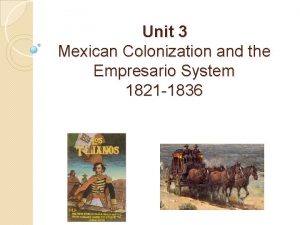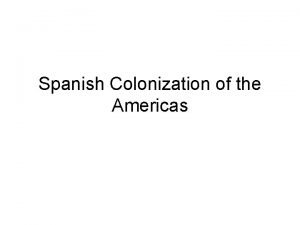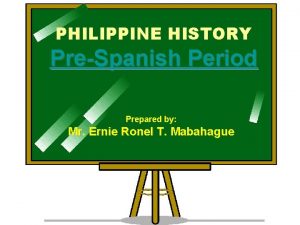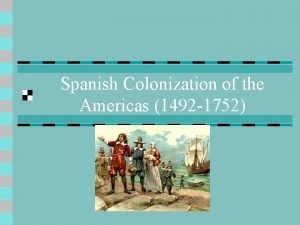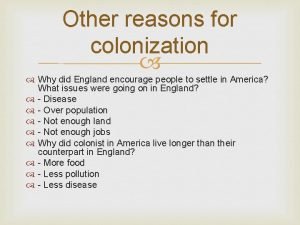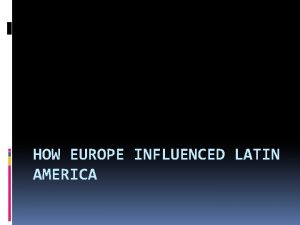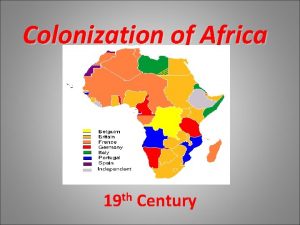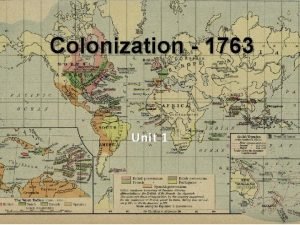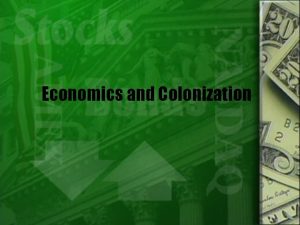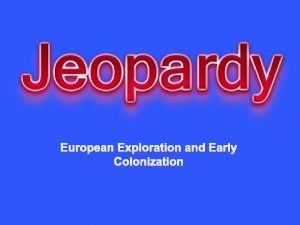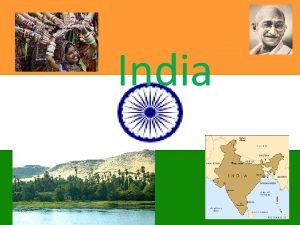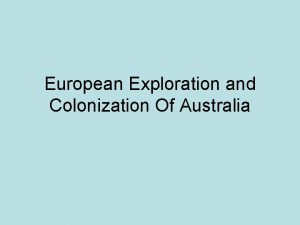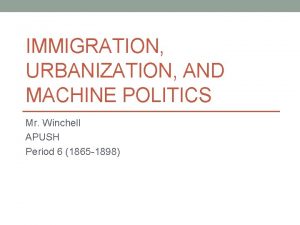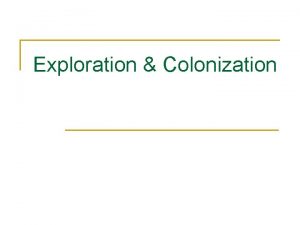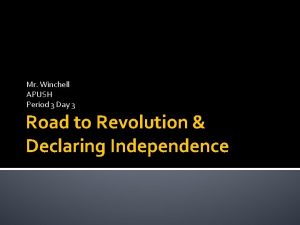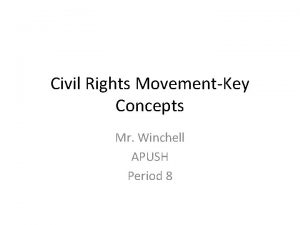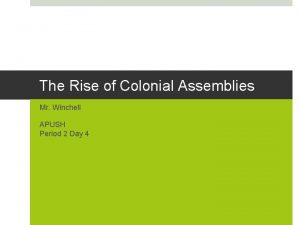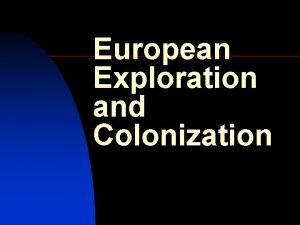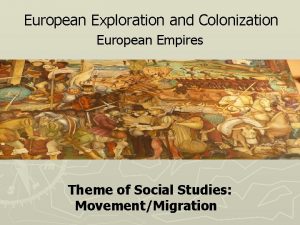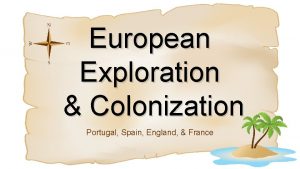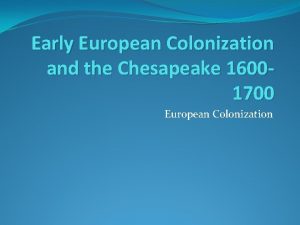European Exploration and Early Colonization Mr Winchell APUSH























- Slides: 23

European Exploration and Early Colonization Mr. Winchell APUSH Period 1 -2

AP Prompt • Evaluate the short term effects of European Exploration and Colonization on the Americas.

Key Concepts-REFERENCE KC REVIEW • 2. 1. I: Spanish, French, Dutch, and British colonizers had different economic and imperial goals involving land labor that shaped the social and political development of their colonies as well as their relationships with native populations.

Locations of Major Native American Groups and Culture Areas in the 1600 s

Motives for European Exploration 1. Crusades → by-pass intermediaries to get to Asia. 2. Renaissance → curiosity about other lands and peoples. 3. Reformation → refugees & missionaries. 4. Monarchs seeking new sources of revenue. 5. Technological advances. 6. Fame and fortune.

Direct Causes = 3 G’s • Political: Become a world power through gaining wealth and land. (GLORY) • Economic: Search for new trade routes with direct access to Asian/African luxury goods would enrich individuals and their nations (GOLD) • Religious: spread Christianity and weaken Middle Eastern Muslims. (GOD) The 3 motives reinforce each other

European Exploration 1400 s to 1600 s Effects • Europeans reach and settle Americas • Expanded knowledge of world geography • Growth of trade, mercantilism and capitalism • Indian conflicts over land impact of disease on Indian populations • Introduction of the institution of slavery • Columbian Exchange

F/I War 1750

Comparing the Colonization Process SPANISH • • • Funded by crown Very direct control Strong Catholic missionary impulse More complex socio-political system (race based hierarchy where intermingling of races common) Relatively few women over to colonize BRITISH • • • Joint Stock Companies raised funds & were granted charters (later the crown takes over more directly) Economic development more independent from Mother Country More variance in background, motivation, etc. of colonists Little intermixing with native population- very rigid racial hierarchy Relatively more women over, as aim was to acquire land populate colonies rather than simply turn a profit

Both Britain and Spain in general… • • • Motivated by Mercantilist goals (Gold, Glory, God!) Used slavery and exploited native populations Had hostile relationships with native populations The French & Dutch: a hybrid approach • Maintained a much looser hold on their colonies (diff from above) • Few Europeans came over • Used trade alliances and intermarriage with American Indians to acquire furs, etc. for export.

Thus began the move from the Old World to the New World

Who Came, and Where did They Settle? Spanish built settlements in the Caribbean, South America and Central America English settled in North America (present day United States) French settled in present-day Canada Dutch settled in present-day New York Africans were brought to work on large plantations in the Caribbean and Southern English colonies

Comparing Three Worlds American Indians Europeans What were their religious beliefs? Nature-based Spiritual relationship between man and Earth A mix: Islam (in some Spread Christianity areas); Nature-based (in Everyone should be Christian other places) What was their government? tribes (simple) confederations empires (complex) nations and kings beginning to have ideas about individual rights What were their economic systems? Communal ownership of land Private ownership of property Live in harmony with land -Labor + land = wealth use it to sustain life and not to create wealth Communal ownership of land Extensive trade in a variety of goods What kind of technology did they have? Bows, arrows, spears and tomahawks Simple farming and hunting tools Depends on area – simple farming tools or complex trading equipment Advanced weapons, including guns, cannons and armor Navigational abilities West Africans Kingdoms w/ rulers Council of elders


The English Colonies In the 1600 s, English settlers arrived in North America • English colonization differed from Spanish & French because the English government had no desire to create a centralized empire in the New World • Different motivations by English settlers led to different types of colonies

Migrating to the English Colonies • 17 th century England faced major social changes: • The most significantly was a boom in population; Competition for land, food, jobs led to a large mobile population (vagrants? ) • People had choices: could move to cities, Ireland, Netherlands, or America (but this was most expensive & dangerous)

Migrating to the English Colonies • Motives for migration to America: – Religious: purer form of worship – Economic: Escape poverty or the threat of lifelong poverty – Personal: to escape bad marriages or jail terms • Migration to America was facilitated by the English Civil War & Glorious Revolution

Four Colonial Subcultures • The values of the migrants dictated the “personality” of the newly created colonies; led to distinct (not unified) colonies • The Chesapeake • New England • Middle Colonies • The Carolinas & Georgia


Impact of Discovery • Colonization: The establishment of distant settlements controlled by parent country. • Often times natives were forced into work on plantations • An exchange begins between the old world and the new.

Trading Food is Good… Trading Disease is BAD! • Population decrease estimates between 1/3 and 1/2 of native population. • Decrease in population means decrease in workforce. • What will the Europeans do? ? ?

Slave Trade Begins • With so many Natives dying of disease, Europeans turned to the slave trade to replenish labor force. • Africans were more resistant to Old World disease and less familiar with New World (less likely to escape). • Europeans began using these slaves in the New World.

The Columbian Exchange • An exchange of living things between the Old World (Europe, Asia, Africa) and the New World (the Americas)
 Early european exploration and colonization resulted in
Early european exploration and colonization resulted in Unit 2: exploration and georgia colonization
Unit 2: exploration and georgia colonization Unit 1 exploration and colonization
Unit 1 exploration and colonization Spanish north america
Spanish north america Why did western nations desire lands in the pacific rim?
Why did western nations desire lands in the pacific rim? French colonization apush
French colonization apush European exploration map
European exploration map Spanish exploration and conquest apush
Spanish exploration and conquest apush Factors for european exploration
Factors for european exploration What were the motives for european exploration
What were the motives for european exploration The 3 g's of european exploration
The 3 g's of european exploration God glory and gold
God glory and gold European explorers webquest
European explorers webquest European exploration economic reasons
European exploration economic reasons Cycle of conquest and colonization
Cycle of conquest and colonization Early cpr and early defibrillation can: *
Early cpr and early defibrillation can: * What role did erasmo seguin and jose antonio navarro
What role did erasmo seguin and jose antonio navarro Colonization for god gold and glory
Colonization for god gold and glory Social classes in the philippines spanish era
Social classes in the philippines spanish era Spanish colonization of the americas
Spanish colonization of the americas Reason for colonization
Reason for colonization Columbian exchange
Columbian exchange Colonial africa
Colonial africa Colonization
Colonization
